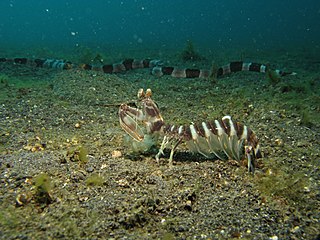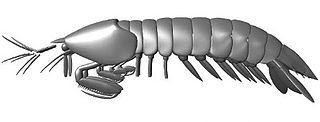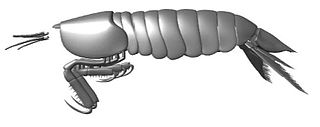
Mantis shrimp are carnivorous marine crustaceans of the order Stomatopoda. Stomatopods branched off from other members of the class Malacostraca around 340 million years ago. Mantis shrimp typically grow to around 10 cm (3.9 in) in length, while a few can reach up to 38 cm (15 in). A mantis shrimp's carapace covers only the rear part of the head and the first four segments of the thorax. Varieties range in colour from shades of brown to vivid colours, with more than 520 species of mantis shrimp known. They are among the most important predators in many shallow, tropical and subtropical marine habitats. However, despite being common, they are poorly understood, as many species spend most of their lives sheltering in burrows and holes.

The Lysiosquillidae or banded mantis shrimps are a family of mantis shrimp, comprising some of the largest known mantis shrimp species. The most common and best known species is Lysiosquillina maculata, the zebra mantis shrimp.

Squillidae is a family of mantis shrimp, the only family in the superfamily Squilloidea. The type genus is Squilla. It is the stomatopod family with the most genera, as follows:

Erythrosquilla is a genus of mantis shrimp, placed in its own family (Erythrosquillidae) and superfamily (Erythrosquilloidea) comprising two species:
Eurysquillidae is a family of mantis shrimp. Formerly placed in the superfamily Gonodactyloidea, it has since been recognised that eurysquillids are closer to families in the Squilloidea, and so Eurysquillidae has been placed in its own superfamily, Eurysquilloidea. The family was first described in 1977 by Raymond Manning.
Platysquilla eusebia is a species of mantis shrimp in the family Nannosquillidae, from the Mediterranean Sea and north-eastern Atlantic Ocean. It is a spearer, and grows up to 7 cm (2.8 in) long.
Aeschronectida is an extinct order of mantis shrimp-like crustaceans which lived in the Mississippian subperiod in what is now Montana. They exclusively lived in the Carboniferous, or the age of amphibians. They have been found mostly in the U.S. and in the British Isles, in 1979 species were found in the Madera Formation in New Mexico. Aeschronectida was first identified appearing in Continental Europe in around 2014. While sharing similar characteristics to Stomatopoda, they lack certain physical characteristics of that taxon. The first species of Aeschronectida is accredited to Frederick R. Schram. They diverge substantially from typical hoplocaridan morphology by having more unmodified thoracopods. It's theorized that these thoracopods evolved to become more specialized, making them potential ancestors to Stomatopoda.
Raymond Brendan Manning was an American carcinologist, specialising in alpha taxonomy and mantis shrimp.
Tetrasquillidae is a family of mantis shrimp containing ten genera:

The Pseudosquillidae are a family of mantis shrimp containing four genera and 11 species.

Acanthosquilla is a genus of stomatopod crustacean. The American carcinologist Raymond B. Manning named and first circumscribed the genus in 1963. As of 2018, the World Register of Marine Species recognizes the following eight species:

Gonodactylus chiragra is a medium to large mantis shrimp that is distributed widely throughout the West Indo-Pacific.

Oratosquilla is a genus of crustaceans belonging to the family Squillidae. The species of this genus are found in Indo-West-Pacific. The genus was first described in 1968 by Raymond Brendan Manning.
Erugosquilla septemdentata is a species of shrimp in the family, Squillidae, and was first described in 1994 by Shane T. Ahyong as Oratosquilla septemdentata. The name was revised to Erugosquilla septemdentata in 1995 by Raymond B. Manning.

Acanthosquilla crosnieri is a species of stomatopod crustacean in the Nannosquillidae family. It has been found in waters off the Marquesas, at depths of 0 - 100 m but more usually at 7 - 25 m, and was first described by the Australian carcinologist Shane T. Ahyong in 2002.
Alima neptuni is a species of shrimp in the Squillidae family, and was first described in 1768 by Carl Linnaeus as Cancer neptuni.

Tyrannophontes is an extinct genus of mantis shrimp that lived during the late Carboniferous period in what is now the Mazon Creek fossil beds of Illinois. It is the only genus in the family Tyrannophontidae. The type species, T. theridion, was described in 1969 by Frederick Schram. A second, much larger species, T. gigantion, was also named by Schram in 2007. Two other species were formerly assigned to the genus, but have since been reclassified.

Daidal is an extinct genus of mantis shrimp that lived during the Carboniferous period. It is the only genus in the family Daidalidae. Three species are currently placed within the genus. Fossils of the type species, D. acanthocercus, have been found in the Bear Gulch Limestone of Montana. A second species, D. pattoni, is known from the Lower Limestone Formation of Scotland, and the third species, D. schoellmanni, was discovered in Westphalia, Germany. The genus has been proposed to be polyphyletic, with D. pattoni possibly being an earlier diverging lineage, though more specimens and research are needed to confirm this.

Gorgonophontes is an extinct genus of mantis shrimp that lived during the late Carboniferous period in what is now the United States and Belgium. It contains two named species. The type species, G. peleron, was described in 1984 by Frederick Schram based on 100 specimens found in Nebraska and Iowa. A second species, G. fraiponti, was first named from multiple specimens found near Liège in 1922 and later reassigned to the genus.
Ursquilla is an extinct genus of mantis shrimp that lived in Israel and Jordan during the Campanian stage of the Late Cretaceous period. It contains a single species, Ursquilla yehoachi.













